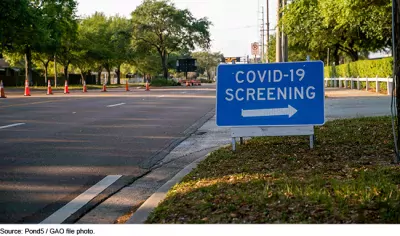New GAO Report Suggests Many Ways to Improve COVID Response
While it may feel like the pandemic is slowly fading, the Delta variant has brought an uptick in new cases among unvaccinated people.
Today GAO issued a new report that includes 15 new recommendations for applying lessons learned from the COVID-19 pandemic to ensure that the nation improves its response to the current pandemic and is ready for future public health emergencies as well.
We first began reporting on the federal response to COVID-19 in June 2020. In previous reports, we made a total of 72 recommendations to federal agencies about improving the national response. Of these, 16 have been fully implemented. Agencies agreed with 57 of the recommendations, and most are in the process of being implemented. Today we are releasing our seventh comprehensive report.
Today’s WatchBlog post explores some of our important recommendations to federal agencies—including ones that could improve transparency in how taxpayer funds are spent, COVID-19 testing, and address medical supply shortages.
Adding transparency in how HHS obligated COVID-19 funding
Trillions of dollars were appropriated in the federal response to COVID-19. About $484 billion was appropriated to HHS under the 6 coronavirus-related relief laws. However, we found that HHS could provide better information on how and when it plans to spend this money. We are recommending that HHS improve transparency over the tens of billions of dollars in unspent relief funds. Another $500 billion was appropriated to the Department of the Treasury to provide direct funding to states, localities, and tribal governments. We found that OMB and Treasury have not yet provided guidance to state and local governments, and are recommending that they issue timely guidance.
COVID-19 testing and test processing
The Centers for Disease Control and Prevention (CDC) initially developed a flawed COVID-19 diagnostic test. This caused challenges for the rollout of testing nationwide. While CDC has taken steps to improve its process for developing tests, additional actions could help strengthen its preparedness and enhance the nation’s testing capacity during a future infectious disease outbreak.
For example, establishing contracts with test kit manufacturers prior to a public health emergency could allow CDC to supplement the supply of tests it produces, and aid the rapid manufacturing and deployment of test kits during a future public health emergency. We are recommending that CDC assess its needs for goods and services for the manufacturing and deployment of diagnostic test kits in public health emergencies, including the potential role of establishing contracts in advance of an emergency.
Image

CDC also has opportunities to improve its collaboration and communication with stakeholders like public health and private laboratory partners, which could enhance surge capacity testing.
While planning for and having more test kits is important, so is planning for how to quickly process those tests for results in laboratories. Prior to the pandemic, CDC and stakeholders had recognized the need to enhance laboratory surge capacity, but hadn’t established a plan to do so. An effective plan would include objectives, timeframes, and agency and stakeholder roles and responsibilities. We are recommending that CDC develop such a plan in coordination with appropriate stakeholders.
Medical supply shortages and the domestic supply chain
Prior to the pandemic, the U.S. generally depended on foreign suppliers for certain types of personal protective equipment (PPE), including nitrile gloves and surgical gowns. However, shortages during the pandemic highlighted the need for the federal government to better engage domestic manufacturers.
In January, we reported that the Department of Health and Human Services (HHS) had not developed a process for engaging key nonfederal stakeholders and Congress on a supply chain strategy for pandemic preparedness, including the role of the Strategic National Stockpile. While we recommended that HHS do so—and officials agreed with us—as of May, HHS had not implemented this recommendation. Engaging with key nonfederal stakeholders—in meaningful, proactive ways to obtain their business and industry expertise—and with Congress is critical for developing strategies to build a sustainable domestic medical supply manufacturing base.
To learn more about our recommendations for improving the federal response to COVID-19 and to read our new report visit our key issue page on the coronavirus.
- Comments on GAO’s WatchBlog? Contact blog@gao.gov.
GAO Contacts
Related Products

GAO's mission is to provide Congress with fact-based, nonpartisan information that can help improve federal government performance and ensure accountability for the benefit of the American people. GAO launched its WatchBlog in January, 2014, as part of its continuing effort to reach its audiences—Congress and the American people—where they are currently looking for information.
The blog format allows GAO to provide a little more context about its work than it can offer on its other social media platforms. Posts will tie GAO work to current events and the news; show how GAO’s work is affecting agencies or legislation; highlight reports, testimonies, and issue areas where GAO does work; and provide information about GAO itself, among other things.
Please send any feedback on GAO's WatchBlog to blog@gao.gov.




